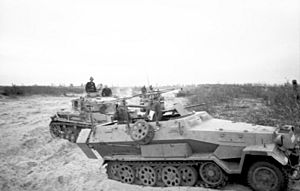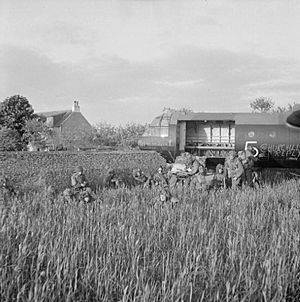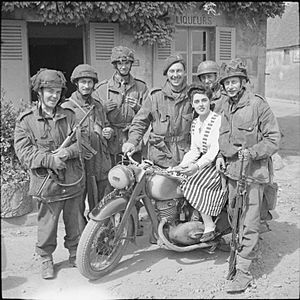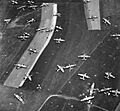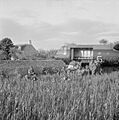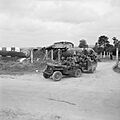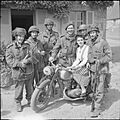Operation Mallard facts for kids
Quick facts for kids Operation Mallard |
|||||||
|---|---|---|---|---|---|---|---|
| Part of the Normandy landings | |||||||
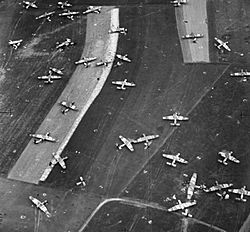 Landing zone 'N' 7 June 1944 |
|||||||
|
|||||||
| Belligerents | |||||||
| Commanders and leaders | |||||||
| Units involved | |||||||
| 6th Airborne Division | 716th Infantry Division 21st Panzer Division |
||||||
Operation Mallard was a special mission during World War II. It happened on June 6, 1944, as part of the D-Day landings in Normandy. British soldiers, called airborne forces, were involved.
Their goal was to fly in more soldiers and equipment using gliders. These reinforcements were for the 6th Airborne Division. This division was already fighting on the left side of the British invasion beaches.
The gliders landed in two main areas. One was west of the Caen canal and the other was east of the River Orne. Operation Mallard was the third airborne mission for this division on D-Day. Earlier, soldiers had captured the Pegasus and Horsa Bridges. Another mission, Operation Tonga, dropped paratroopers near Caen.
Operation Mallard was a big success. Out of 256 gliders, 246 landed safely. These gliders brought the first Tetrarch tanks ever used in combat by air.
Contents
Why This Mission Was Important
Plans for the D-Day invasion included five attacks from the sea. These were supported by airborne troops on both sides. The 6th Airborne Division was chosen to land on the left side of the British attack.
Their main goal on D-Day was to capture two important bridges. These bridges crossed the Caen canal and the River Orne. They needed to capture them without damage. The division also had to destroy the Merville gun battery. This German gun battery could fire on ships landing at Sword beach. To stop German help from coming, the 6th Airborne Division also blew up bridges over the River Dives. Then, they dug in around Ranville to protect the left side of the invasion.
The two bridges were captured by soldiers who landed in gliders. This was done by a special company from the 2nd Battalion Oxfordshire and Buckinghamshire Light Infantry. As part of Operation Tonga, other paratrooper brigades helped. The 5th Parachute Brigade defended the captured bridges. The 3rd Parachute Brigade destroyed the Merville gun battery and the Dives bridges.
The 6th Airlanding Brigade was almost as big as the two paratrooper brigades combined. But there weren't enough planes to fly them all at once. So, they came later. Each of their three infantry battalions had many soldiers. They also had Anti-tank guns, mortars, and Vickers machine guns. The plan for these troops depended on how well the first D-Day attacks went. If all went well, they would cross the waterways and expand the division's position.
Gliders Used in the Operation
Planes that had flown earlier missions were refueled and fixed. They got ready to tow gliders that evening. This airlift used 226 Airspeed Horsa gliders. Each Horsa glider had two pilots. It could carry up to 28 soldiers. Or it could carry two jeeps, or a jeep and an artillery gun.
The division's heavier gear came in thirty General Aircraft Hamilcar gliders. Twenty of these carried Tetrarch light tanks and their crews. These tanks belonged to the 6th Airborne Armoured Reconnaissance Regiment. Other Hamilcar gliders carried fuel, Universal Carriers, motorcycles, and more jeeps.
German Forces They Faced
The German 716th Infantry Division guarded the coast. They had eight infantry battalions. These soldiers were not well-equipped. Many were conscripts from other countries.
The 21st Panzer Division moved into the area in May 1944. Their battalions were near Caen. This division was new, but many of its officers were experienced. They had some older tanks and armored vehicles. Further away were the 12th SS Panzer Division and the Panzer Lehr Division. These were less than a day's march away.
The Mallard Mission
After the first airborne and sea landings, the 21st Panzer Division got permission to attack. This was just after noon on June 6. A German general told them they had to push the British back into the sea.
East of the River Orne, German troops moved towards the captured bridges. Allied artillery and planes quickly attacked them. This caused many losses. Later, west of the Caen canal, other German units reached the coast. They met up with defenders near Lion sur Mer. The German units waited for new orders.
Back in England, 256 gliders for Operation Mallard took off. They carried the rest of the 6th Airborne Division's men and equipment. The British Royal Air Force (RAF) sent 15 squadrons of fighter aircraft to protect them. The gliders crossed the English channel safely. They arrived in Normandy at 9:00 PM. It was still daylight, so navigation was easier than for earlier missions. As the gliders came in, German defenders fired at them.
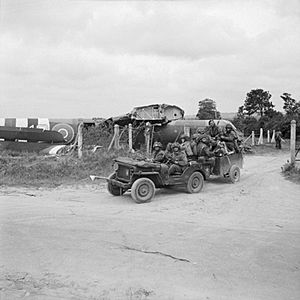
The gliders aimed for two landing areas. Landing Zone 'W' (LZW) was east of Saint-Aubin-d'Arquenay. Landing Zone 'N' (LZN) was north of Ranville. The remaining soldiers of the 2nd Oxfordshire and Buckinghamshire Light Infantry landed at LZW. The 6th Airlanding Brigade headquarters and the 1st Battalion, Royal Ulster Rifles landed at LZN. The 6th Airborne Armoured Reconnaissance Regiment also landed at LZN with their Tetrarch light tanks. This was the first time tanks were flown into battle.
Major-General Richard Nelson Gale watched the gliders arrive. He later wrote how relieved they were to see these reinforcements.
The Germans fired mortars and small arms at the arriving gliders. But there were very few casualties. The German commander of the 21st Panzer Division saw the gliders. He thought they would cut off his supply lines. So, he ordered his troops to pull back. The gliders' arrival accidentally stopped the only German tank attack on D-Day.
From LZN, the 1st Battalion, Royal Ulster Rifles, moved south. They captured the villages of Longueval and Sainte-Honorine-de-Chardronnette. The 211th Battery, 53rd (Worcester Yeomanry) Airlanding Light Regiment, Royal Artillery arrived at LZN. They had eight 75 mm Pack Howitzers. They were firing at German targets less than 30 minutes after landing. The 2nd Battalion, Oxfordshire and Buckinghamshire Light Infantry, crossed the Caen canal and River Orne bridges. By midnight, the 6th Airborne Division had achieved all its D-Day goals.
What Happened Next
The arrival of the 6th Airlanding Brigade made the 6th Airborne Division much stronger. Many of the paratrooper battalions were missing soldiers because their drops were scattered.
By 11:00 AM on June 7, the 2nd Battalion, Oxfordshire and Buckinghamshire Light Infantry, had taken Escoville. This was about 3 miles south of Ranville. The 1st Battalion, Royal Ulster Rifles, took Longueval without a fight. They were ordered to go another mile to Sainte-Honorine. But they were caught in the open by German artillery and by mistake, guns from a British ship. They couldn't move forward, but they held Longueval. The 12th Battalion, Devonshire Regiment, arrived on the evening of June 7. They took over defending the Bas de Ranville area.
D-Day cost the 6th Airborne Division many soldiers. 821 were killed, 2,709 were wounded, and 927 were missing. The division stayed holding the area around the Orne bridges. They only did patrols and small attacks until August 17. Then, they crossed the River Dives. By August 27, the division reached Berville sur Mer. They stayed there until early September. Then, they were sent back to England.
Images for kids


